
Tug Boat Photos
River Tugs
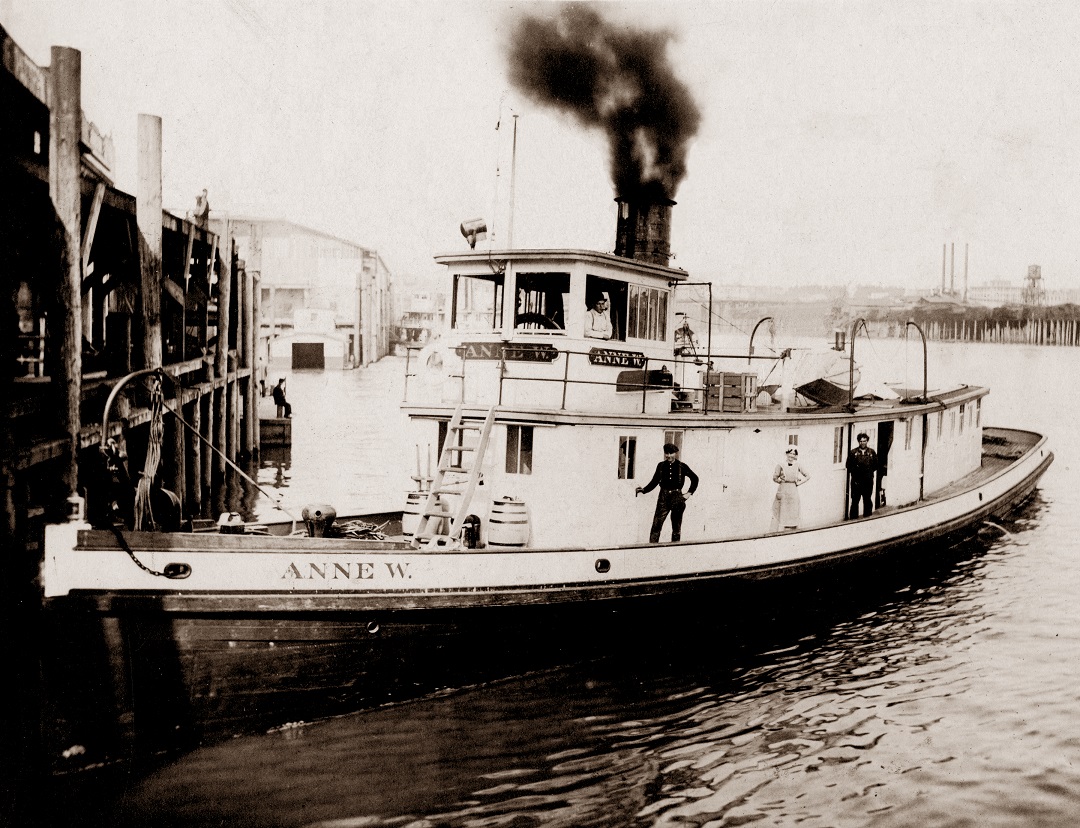
The Anne W. steam tug Pacific Northwest
The Anne W. was built as a steam tugboat in 1913 in a Portland, Oregon shipyard
Fine original photo likely taken at Seattle early in her career. Photo required a lot of retouching but came out fine. The "steamboat" style pilot house added to the charm along with the crew including the lady member who may have served as both cook and chambermaid. The engineer stands behind her.
Career of a Tugboat: The Anne W.
By Eleanor Boba
Posted 2/06/2015
HistoryLink.org Essay 11023
historylink.org
For more than 50 years, the tugboat Anne W. worked Northwest waters, much of the time hauling barges from a gravel pit in Steilacoom to the shores of Lake Union in Seattle. Before being retired from service in 1967, the tug survived many misadventures, including getting lost on the way to Alaska, sinking in the Ballard locks, and grounding on Vashon Island. This People's History of the Anne W. was written by Eleanor Boba.
Gravel Gertie
They called her "Gravel Gertie," the tug that routinely plied the waters between the Steilacoom gravel pit and the home of Pioneer Sand & Gravel Company on Lake Union. The Anne W. was a fixture going through the Hiram M. Chittenden Locks in Ballard for decades. When she was retired in 1967, Bob Dorsey, her chief engineer, told a reporter "We've worn a groove in the water."
The Anne W. was built as a steam tug in 1913 in a Portland shipyard. During her career she saw service from the Columbia River to Alaska, before settling in on Puget Sound. In 1927 she was converted from steam to diesel. In a half-century working life she survived two sinkings and one grounding, as well as an unexplained disappearance on an early trip up to Cook Inlet in Alaska.
An item in The Seattle Times, dateline Seward, Alaska, April 15, 1916, refers to that unsolved mystery:
"The steamship Dora arrived from Seldovia last night and says nothing has been heard of the tugs Crosby and Anne W., which, with three barges in tow, sailed from Hoonah April 4, on their way from Seattle to Seward. The tugs and barges had recently been purchased by the Alaskan Engineering Commission for use on Cook Inlet in connection with railroad construction."
Most of the tug's career was in the service of Pioneer Sand & Gravel, whose products were much in demand for building materials: plaster, mortar, and concrete. In fact, she starred in an article about the industry published in The Seattle Times in 1953 and titled "Legacy of the Ice Age." The accompanying photo of the Anne W. pulling two heavily-laden scows was taken by renowned photographer Joseph Scaylea. Similar photos in the collection of the Puget Sound Maritime Historical Society are attributed to another well-known photographer, Joe Williamson.
Misadventures
The first sinking of the Anne W. occurred in 1944 and in the one of the worst possible locations: the "government locks" (the Hiram M. Chittenden locks in Ballard). The sinking was blamed on an errant log or "deadhead" that pierced her hull during the cycling of the lock. According to The Seattle Times of February 22, 1944:
"The Annie [sic] W., a 100-foot funnel stern towboat, sank so quickly that crew members had barely time to jump from the tug to an adjacent barge before her decks were awash. No feet were wet, but the tug's cook lost his overcoat in the rush."
Needless to say, the tug was also raised from the lock in a huge rush with the assistance of six divers, two slings, and an Army Transport Service crane barge.
A second sinking took place without warning or explanation at her home moorage on Lake Union in 1963. The Pioneer Sand & Gravel Company's plant was located at 901 Fairview Avenue N, approximately where Duke's Chowder House is located in 2015. The watchman had seen nothing amiss on his morning rounds. However:
"About three hours later, men aboard the nearby Navy destroyer escort Whitehurst noticed the stern of the tug was beginning to sink. A party went over in a small boat, but by then the tug was mostly under water" (The Seattle Times, October 26, 1963).
A Foss Launch and Tug Company derrick was pulled into service to raise the sunken tug.
Two years after that incident came the grounding of the Anne W. and two gravel scows on Vashon Island while on the way to Steilacoom. The explanation: The mate had fallen asleep on watch. Skipper Malcolm Lord, who had stood the opposite watch, had himself been asleep below deck. When asked by the Coast Guard examiner why mate Jim Smith hadn't been aware of the grounding, Lord replied "He sleeps like a log, same as I do" (The Seattle Times, March 31, 1965).
Two years later, in 1967, the 54-year-old tug was retired from service. The last mentions of the Anne W. in the newspaper archives are a series of classified ads in 1978 and 1979 offering the tugboat for sale at the price of "$12,500 or offer." The ads note that the boat "needs some repair." No word on any takers.
Tugboat Annie: An Exercise in Disambiguation
In 1933 MGM released a film titled Tugboat Annie starring Marie Dressler and Wallace Beery. The "Annie" of the title was a tugboat operator (not a boat), portrayed by Dressler and, some believe, based loosely on the life of Thea Foss, who in 1889 in Tacoma founded the company that became Foss Maritime. Although not related to the Anne W., the film has other ties to Puget Sound maritime history. The boat that stars as the fictional Narcissus of the film was played by the tugboat Arthur Foss, now a heritage ship docked at Northwest Seaport. (An exact replica of the tug was made for filming in Hollywood.) A number of scenes were shot among the boats on Lake Union and at the Bell Street Pier in downtown Seattle, called "Secoma" in the film.
As two tugs race against each other to rescue a stranded ferry, a character sums up a central message of the film: "These Puget Sound tugboats sure go after the business!"
This essay made possible by:
Seattle Office of Arts & Culture
King County, Washington State
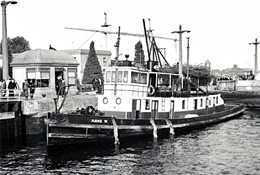
Anne W., Hiram M. Chittenden Locks, Ballard, n.d.
Photo by Joe Williamson, Courtesy Puget Sound Maritime Historical Society
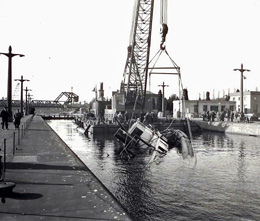
Anne W. being raised by army crane after sinking in Hiram M. Chittenden Locks, Ballard, 1944
Courtesy U.S. Army Corps of Engineers
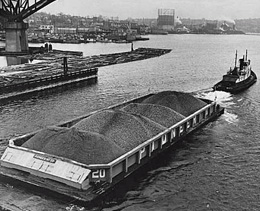
Anne W. with gravel barge, entering Lake Union, Seattle, December 7, 1951
Photo by Joe Williamson, Courtesy Puget Sound Maritime Historical Society
Sources:
The Seattle Times Historic Archives; Puget Sound Maritime Historical Society archives; Internet Movie Database website (www.imdb.com).
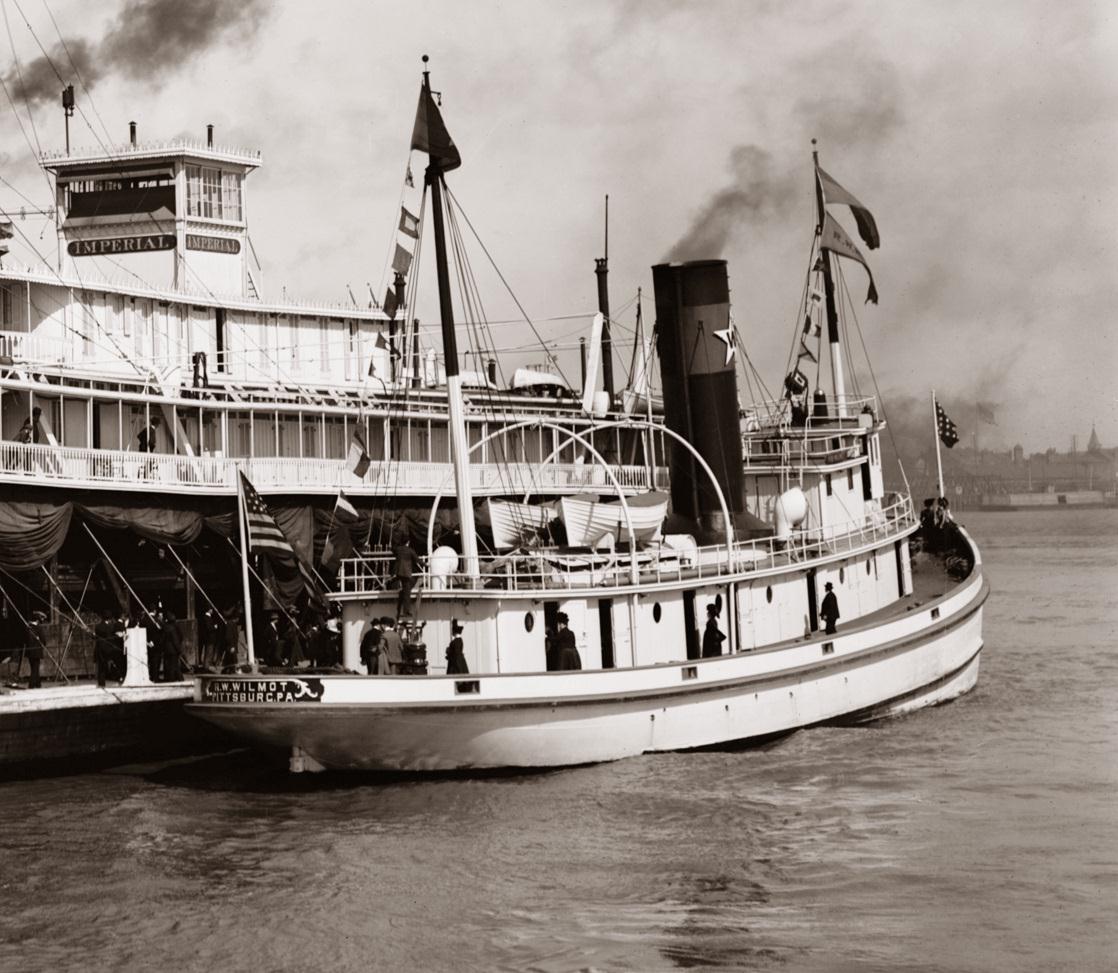
This is a detail from the Library of Congress photo taken at New Orleans by Detroit Publishing between 1890 and 1901 of the great steamboat IMPERIAL dominating the composition with the tugboat R.W. WILMOT on the right which we have on Waybills 4. The R.W. WILMOT ultimately joined the U.S. Navy as the POTOMAC and served until 1922. April F. R. Woods contributed a story to the Albany Woodworks blog on the
R.W. WILMOT . . . tugboat "of PITTSBURGH, PA" listed in Johnson's Steam Vessels of the Atlantic Coast, 1917 as having been launched in 1898 and owned by the Monongahela Con. Coal & Coke Co. 325 Carondolet, Street / New Orleans, Louisiana
(steam launch?) alongside the big steamer IMPERIAL
According to The History of New Orleans, Volume 3 By John Smith Kendall this deluxe tugboat was named for Robert W. Wilmot who was born in Pittsburgh, PA in 1858. After his father's death in 1898 he took over the prominent coal company W.G. Wilmot Company in New Orleans.
albanywoodworks.com
This Day In New Orleans History, February 19, 1914
Blogger's Note: To celebrate our 100th Albany Woodworks News & Events Blog Post, we look 100 years into our past with 'This Day In New Orleans History.' We visit the pages of the New Orleans Herald for the headlines of the day. Published on Thursdays in eight to fourteen pages, the Herald served Algiers, a neighborhood of New Orleans located on the Westbank opposite the French Quarter on the Mississippi River, and the Central Business District, from 1905-1953.
New Orleans Herald Article February 19, 1914:
The POTOMAC spent her early days as the Tugboat ROBERT W. WILMOT, in service to the W. G. Wilmot Coal Company of New Orleans, before being sold to the military for the Spanish-American war effort.
"Naval Tug POTOMAC had been the R. W. WILMOT. The reported abandonment (Blogger's Note: Reports of the POTOMAC's abandonment due to ice reached the New York Naval Yard on February 14, 1914, a few days prior to this article) of the United States naval tug POTOMAC in the ice floes of the Gulf of St. Lawrence marks, perhaps, the final chapter in the eventful career of the former New Orleans tug ROBERT W. WILMOT. An Associated Press dispatch received here Monday from St. John, N.F., states that the Potomac is held fast in ice, and was abandoned Saturday night by the thirty-six officers and men of her crew.
This powerful tug was sold to the United States government during the Spanish-American war by the W. G. Wilmot Coal Company of New Orleans, for which company it was built, and during its sixteen years of history as a naval tug participated in numerous thrilling rescues of life and vessels at sea, and had braved the dangerous ice coasts of the far north and south almost to Cape Horn. Shortly after being sold to the government, and rechristened, the Potomac was assigned to the Atlantic fleet off Cuba, and salvaged the Spanish steamer Sandoval, and assisted in saving and towing to American docks a number of other Spanish vessels captured or disabled in the battle off Santiago, Cuba.
The Potomac assisted in towing the world's largest floating dry dock, the Dewey, from Sparrows Point, Md., to Manila, having taken the dry dock as far as the Suez Canal. The POTOMAC also had the distinction of being the first relief vessel to reach Martinique after the great earthquake disaster a few years ago (Blogger Note: Author may be referring to the 7.9 Martinique Earthquake, December 3, 1906).
The former ROBERT W. WILMOT was rechristened as the USS POTOMAC in service to the United States Navy for many years before being decommissioned in 1922.
The POTOMAC was of steel construction and finished in expensive mahogany and sycamore. It had triple-expansion engines, capable of developing 2000-horse power, and at the time of construction, in 1897, was the most powerful tug in the world. It was sold to the United States navy for $125,000."
Blogger's Note: The POTOMAC left Newport, Rhode Island on January 28, 1914 to rescue vessels icebound off Newfoundland. The POTOMAC was herself iced-in and abandoned on 14 February, but would ultimately survive her icy fate. Salvaged in the late spring, once the ice had thawed, and arriving to the New York Navy Yard in early June, where she received updating and repair.
The POTOMAC returned to the Atlantic Fleet for the remainder of her military service, spending time in the Panama Canal Zone. Decommissioned on June 26, 1922 she was struck from the Naval Vessel Register on July 31st and sold for civilian service to the New Orleans & Bisso Towboat Company on December 1st of that same year.
Posted by April F. R. Woods at 11:11 AM
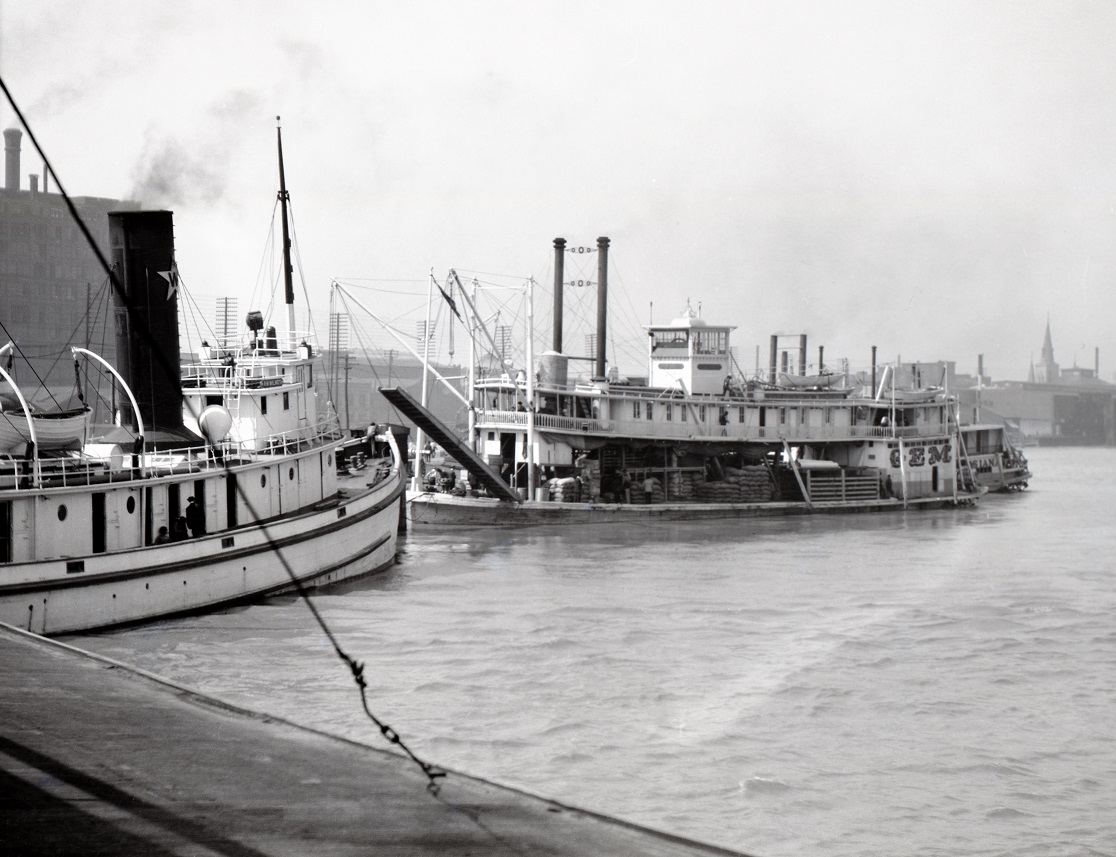
R.W. WILMOT tugboat with the Steamboat GEM at New Orleans
R.W. WILMOT tugboat "of PITTSBURGH, PA" was listed in Johnson's Steam Vessels of the Atlantic Coast, 1917 as having been launched in 1898 and owned by the Monongahela Con. Coal & Coke Co. 325 Carondolet, Street / New Orleans, Louisiana. The WILMOT ultimately joined the U.S. Navy as the POTOMAC and served until 1922.
Gem
Way's Packet Directory Number 2220
Sternwheel packet boat
Built at Jeffersonville, Indiana by Howard in 1898. 135x21 x 3. Three boilers.
Built for Capt. Ben C. Rea to handle cotton above Shreveport on Red River.
Sank just above Shreveport in February 1901 with 650 bales of cotton aboard.
She was in the Red River Line, CharlesP. Truslow, president, and Charles W. Drown, traffic manager.
Again sank, Jan. 30, 1908, a mile above Browns Landing, Red River. Sank at Elevator #3 in the New Orleans harbor, Nov. 23, 1910.
Sold to the Comeaux family for the NewOrleans - Bayou Sara trade and burned at Hahnville Landing, Louisiana, on Feb. 14, 1914 with loss of five of the crew. Both pilots lost their lives in this blaze, Eddie Comeaux and William E. Barre.
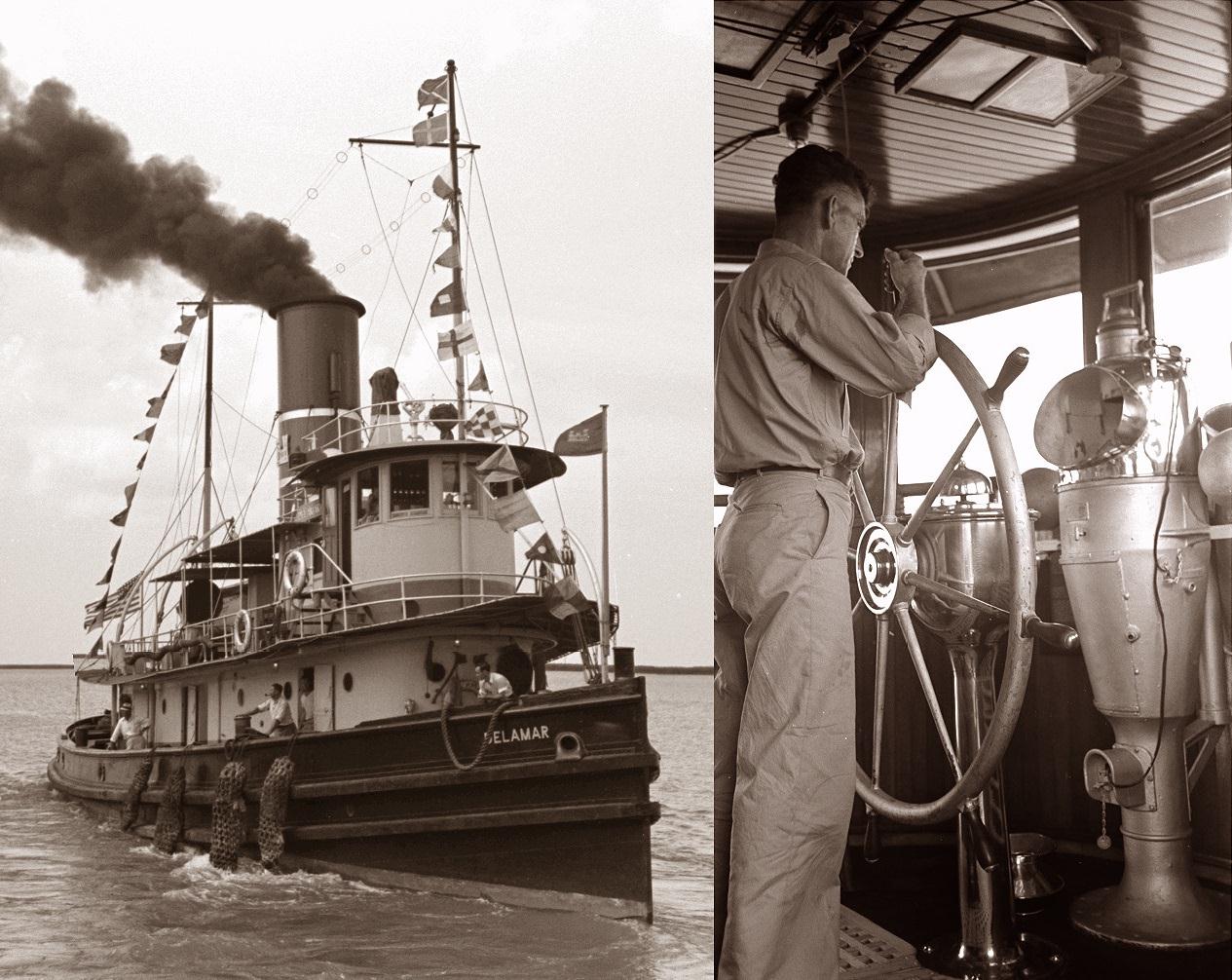
Tugboat, Delamar on the Southwest Pass of the Mississippi River at Burrwood, Louisiana near the mouth of the Delta.
Attached 2 photos from the Library of Congress of the Delamar, a U.S. Engineers tugboat photographed in Sept 1938 by Russell Lee at Burrwood, Louisiana which was located on the Southwest Pass of the Mississippi River near the mouth of the Delta where that channel emptied into the Gulf of Mexico. (Researched from wikipedia):
Wikipedia
Burrwood was established and maintained by the Army Corps of Engineers to serve as a base for dredging operations, jetty work, and other activities required to maintain navigable conditions along this channel.
Due to coastal erosion the community was finally abandoned.
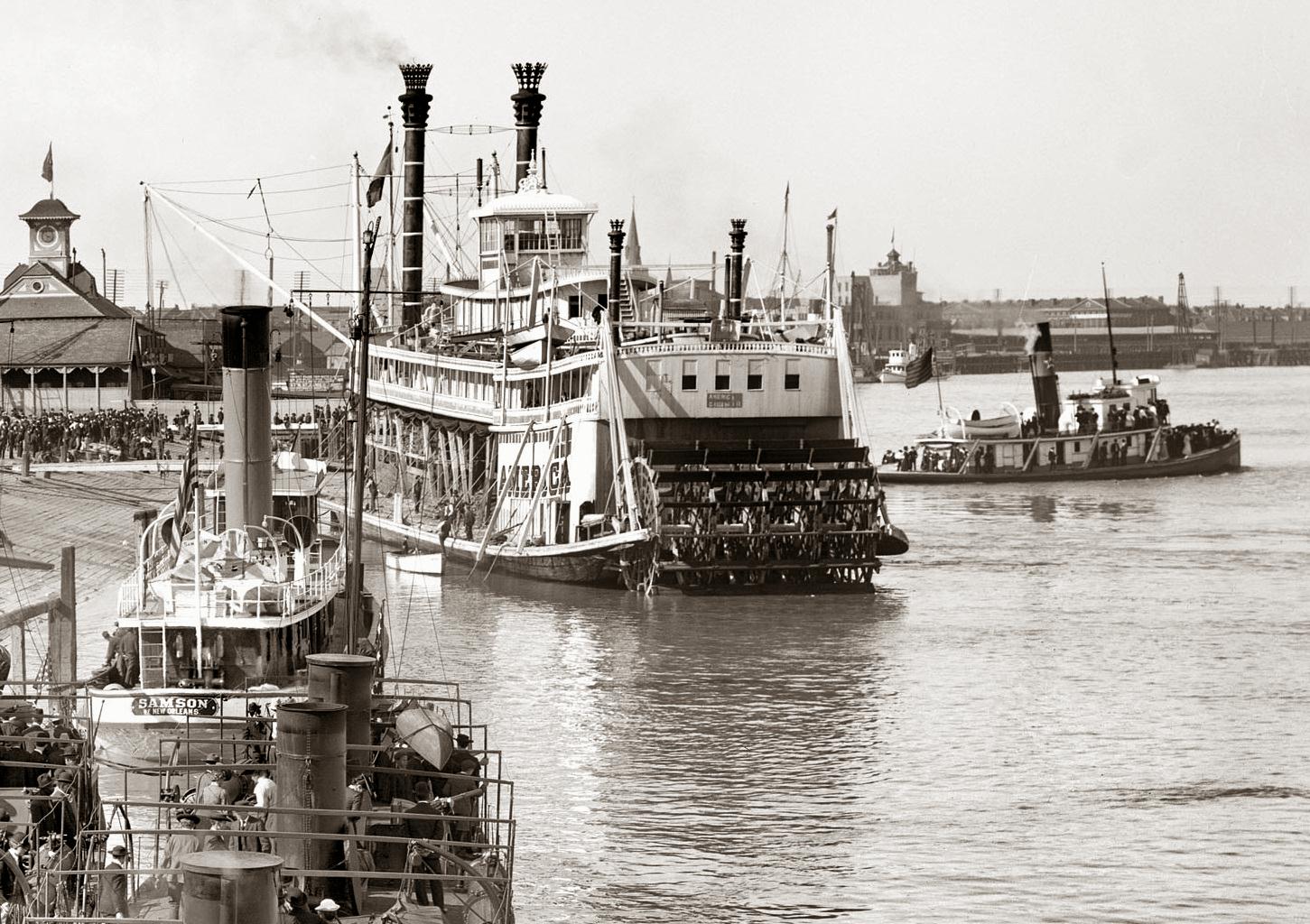
Detail from the upper right hand quadrant of a 1906 photo of Captain Cooley's steamboat AMERICA (center) with the tugboat SAMSON on the left and an unidentified tugboat on the right. For more photos of the America, go to a page dedicated to Cooley's America at this site.*
The SAMSON transported the mayor of New Orleans and the governor of Louisiana to the Industrial Canal lock on Feb 6, 1923. Below is an excerpt from Mary Lou Widmer's "New Orleans in the Twenties" published by Gretna Pelican Publishing Co. in 1993 regarding that event on page 108 - THE INDUSTRIAL CANAL:
"The Inner Harbor Navigation Canal (the Industrial Canal), completed in April 1921, was the realization of the age-old dream of connecting the Mississippi River with Lake Pontchartrain.
Built at a cost of $19 million, it provided industrial sites on deep water. It was dedicated May 5, 1921.
On February 6, 1923, the tugboat SAMSON chugged from the foot of Canal Street to the Industrial Canal lock. The water was then lowered six feet from the level of the river to the level of the lake, which took ten minutes. Governor Parker, Mayor Andrew McShane, and Dock Board officials were aboard the SAMSON."
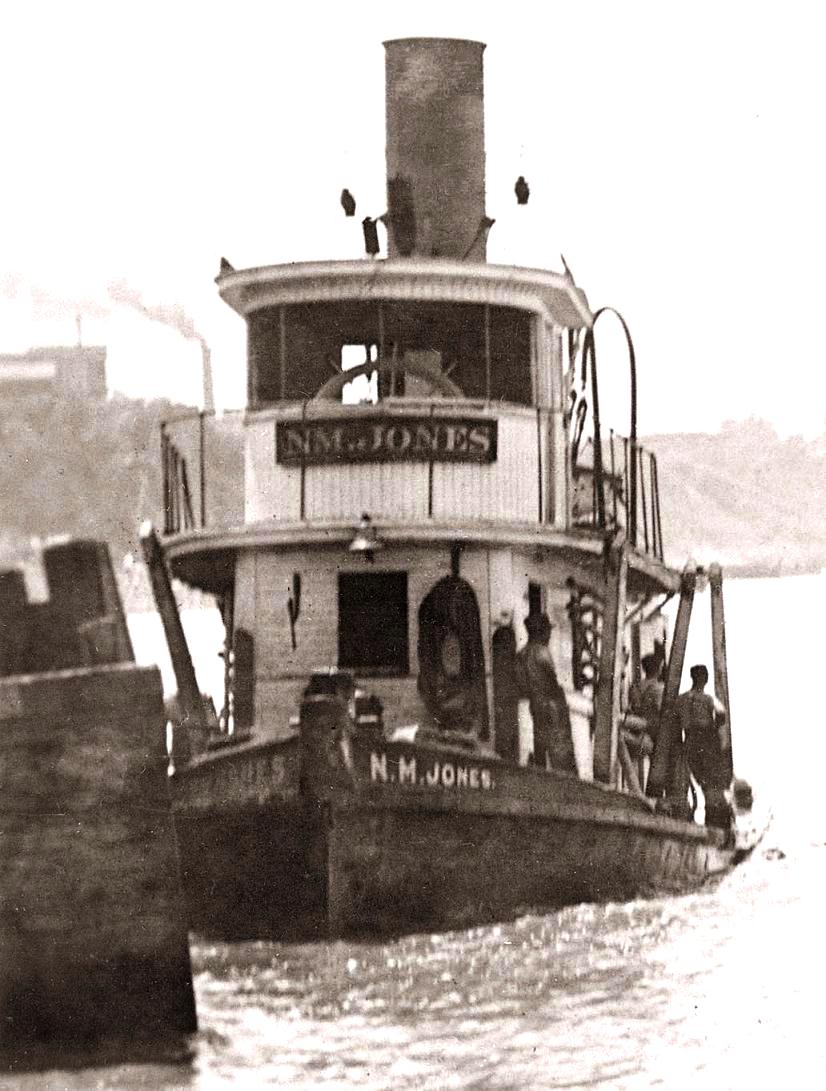
Tugboat N.M. JONES
N.M. JONES
Screw propeller Tugboat
Way's Steam towboat directory Number 1885
Built at Pittsburgh, Pennsylvania, 1872
Metal hull tug built for W. H. Brown, coal operator; stationed at Memphis as a harbor boat, first for Brown's Line, then for Combine. Sometime around 1885, she raced the Ida Patton from Mound City, Arkansas to the Memphis harbor, and lost. In March, 1897, with Captain McNeely on board, she rescued the Defender when that boat broke down at Cairo with a loaded tow
Renamed NORMAN R. in 1937. La Crosse photo.
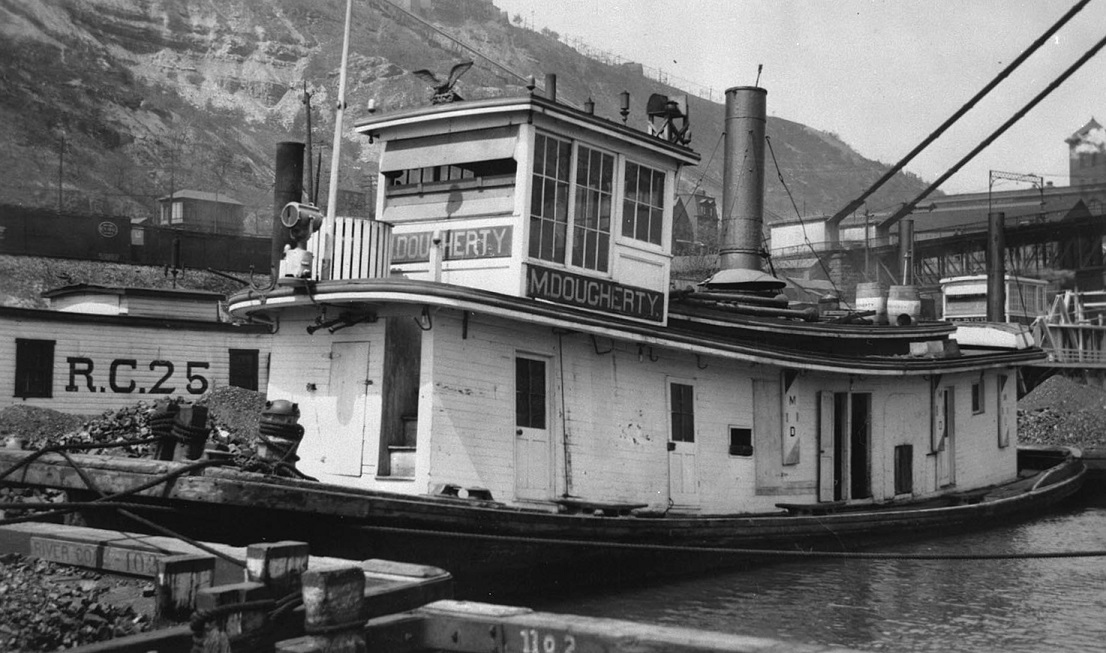
Ohio River tugboat M. DOUGHERTY 1893-1930
From the LaCrosse collection.
M. DOUGHERTY
Screw propeller Tugboat
Way's Steam Towboat Directory Number 1671;
Built in 1893 at Pittsburgh, Pennsylvania
Originally owned by Brown's Line coal operators in Pittsburgh.
Named for Captain Mike Dougherty.
The tugboat did harbor work at Brown's Landing and then went into the Combine in 1900.
Sold to the Nugent Sand Company and renamed TERRA in July 1930.
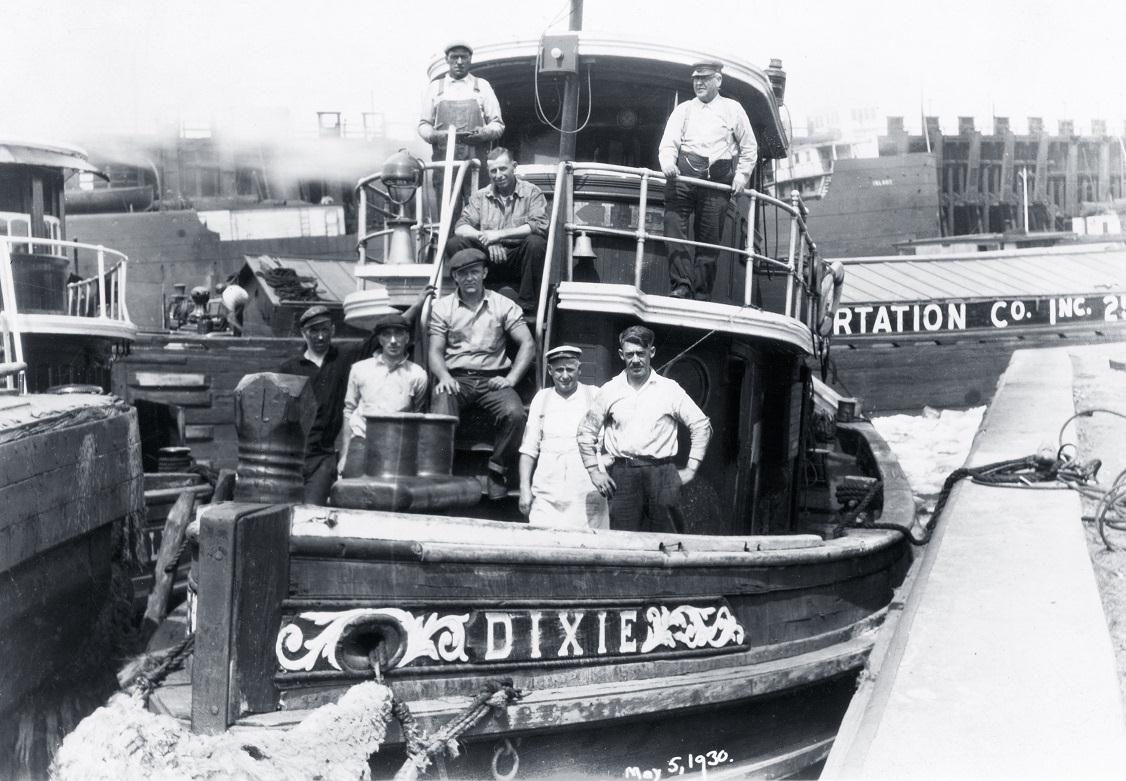
Tugboat DIXIE, Cap'n & Crew - May 1930
The Tugboat DIXIE photographed on the 5th of May, 1930 in an unknown port. Could have been in the Northwest at Seattle or in a port on the East Coast.
Captain (upper right) and 7 crew members. The gents in the upper left and lower left may have worked in the engine room. The fellow lower right in the white cap appears to be wearing a white apron so he may have been the cook.
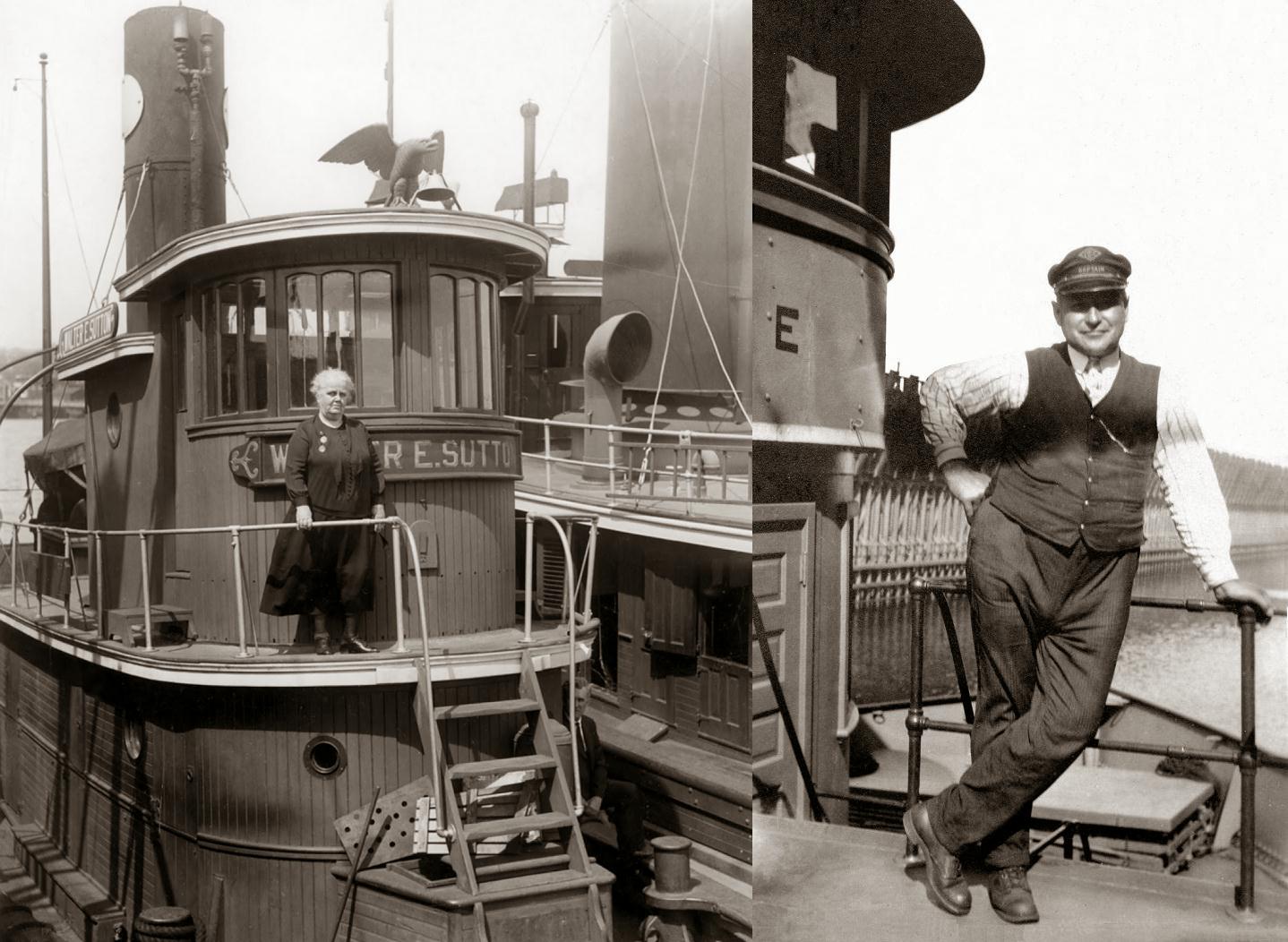
First photo above is of Kate Sutton, owner and manager of the Providence Steamboat Company in Rhode Island on board the tugboat WALTER E. SUTTON.
When asked if she was the inspiration for the fictional character "Tugboat Annie," Kate reportedly said "I hope not!" Photo courtesy of Providence Steamboat Company collection, Steamship Historical Society Archives, www.sshsa.org.
The photo of Kate came from a wonderful article on possible real life candidates for the title character in the 1933 MGM movie TUGBOAT ANNIE starring Marie Dressler and Wallace Beery that was filmed on Puget Sound in Washington state. The movie was based on several early short stories by Canadian writer Norman Reilly Raine that were published in The Saturday Evening Post. Raine wrote 75 ANNIE stories in all, the first was published in July, 1931.
SOURCE OF THE SUTTON PHOTO:
INSIDE PASSAGE
The Blog of the Puget Sound Maritime Historical Society
Sunday, October 18, 2015
psmhsinsidepassage.blogspot.com
"Deconstructing Annie"
Filming Tugboat Annie: Fact and Fiction on Puget Sound by ELEANOR BOBA
The second photo is of an unknown tugboat Captain that I bought on ETSY recently. The last 2 letters in the tugboats name on the pilot house were T E and there is a diamond shaped insignia on the Captain's cap. These items may provide clues to identify this tugboat and possibly even the Captain himself. His uniform is in much the same style of officers on river steamboat.
Sea going Tugs
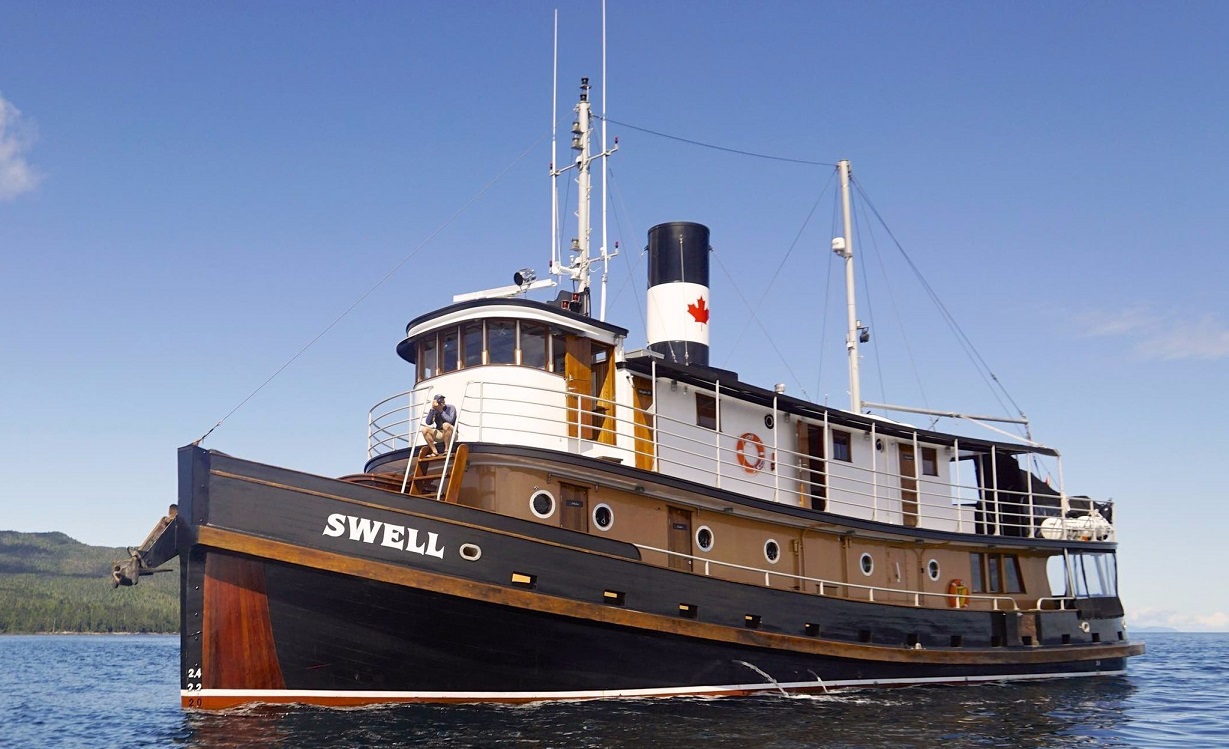
MV SWELL, a modernized passenger tugboat originally built in 1912
"Maple Leaf Adventures takes guests back in time aboard the historic MV Swell to scenic Haida Gwaii, formerly known as the Queen Charlotte Islands, in British Columbia, Canada." San Diego Union-Tribune 18 July 2015
Youtube
MV SWELL Tour & Review
~ Maple Leaf Adventures ~
Cruise Tugboat Tour & Review
Popular Cruising
Published on Aug 13, 2015
Watch our tour and review of Maple Leaf Adventures' MV SWELL, a modernized passenger tugboat originally built in 1912, including Sitka Spruce accommodations with private ensuite; activities: open wheelhouse, anchor chain, top deck lounge, hot tub, aft deck lounge, salon, games, library, wraparound decks, wildlife viewing of humpback whales and orca whales, and fishing; dining: salon, breakfast, lunch, dinner, snacks and drinks; expeditions: kayaking, pontoon boat cruising, more wildlife viewing of clams, crabs, seaweeds, starfish, jellyfish, oyster catchers, bald eagles, sea lions and deer, abandoned whaling station, Haida Gwaii watchmen sites, trees, longhouses, totem poles and scenery at sea and in the forest.
~ Visit Our Website: PopularCruising.com
Cruise Critic review: cruisecritic.com
MV Swell: like touring Canada by yacht sandiegouniontribune.com
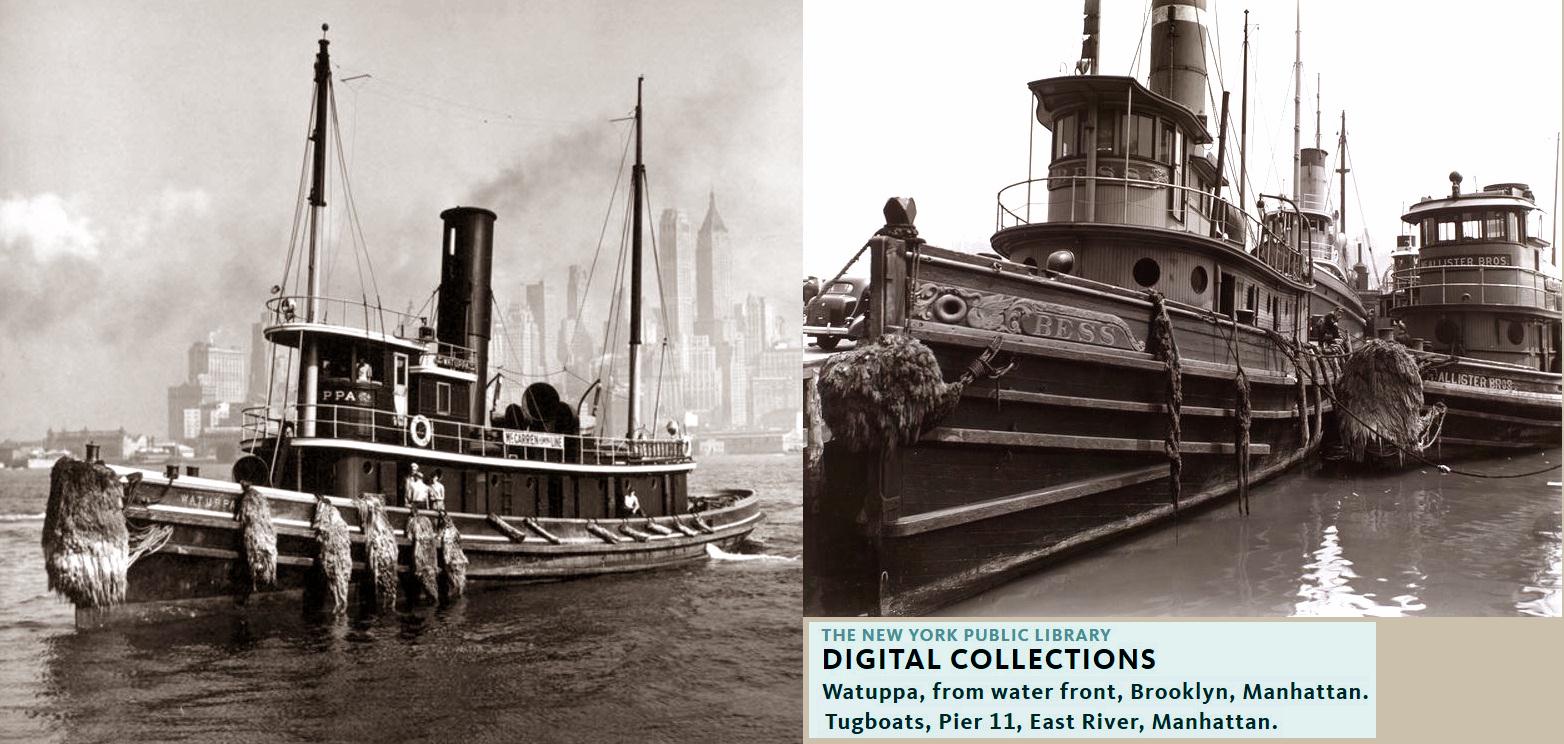
From New York Public Library's Digital Collections
Both photographs by Berenice Abbott, 1936
Left: Tugboat WATUPPA, East River, Brooklyn, New York
Right: Tugboats BESS and "McALLISTER Bros." Pier 11 East River Manhattan
Library of Congress photo of Tugboat CORNING:
Caption from
Tugboats of New York: An Illustrated History
by George Matteson
New York University Press 2005
available in print from Barnes & Noble: barnesandnoble.com
"The Lackawanna Railroad tug CORNING is shown here getting cinder and ash vacuumed from her ash pit. A modified rail car is used to collect the debris. The day-to-day care of a coal-fired steam tug such as the CORNING was a costly and time-consuming business. Coal had to be loaded and ash removed every few days. Water was required every day, and stoking the boilers required the constant labor of at least one man. Husbandry of the engine itself required another set of engineers and oilers. Conversion from coal to oil-fired steam reduced crew, labor, and expense considerably; but the advent of the diesel engine interrupted the move toward better efficiency in steam power."
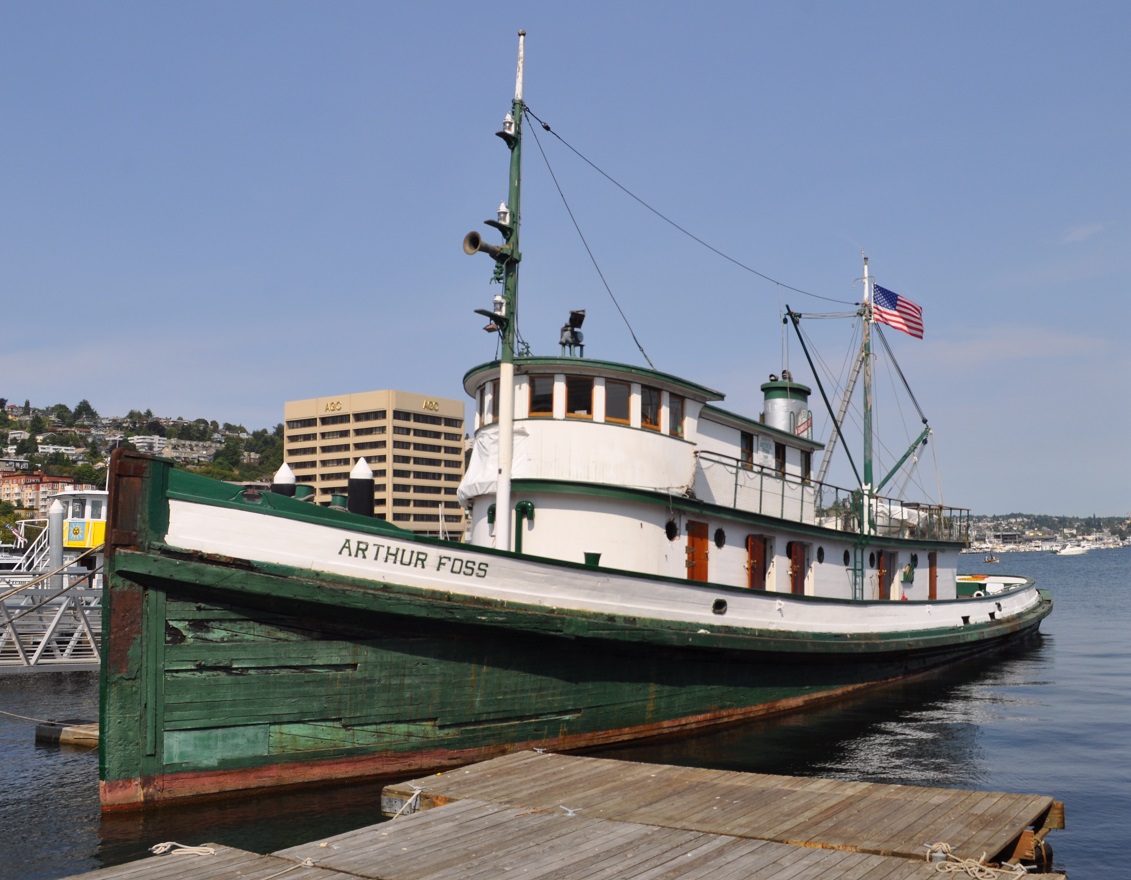
Arthur Foss: Iconic Tugboat of the Northwest
Northwest Seaport
Published on Apr 9, 2014
[Photo cropped and reduced from Wikimedia file]
Keeping It Alive for the Next Generation! "I think the future of the 'Foss' lies in education and getting kids out. It would be great to see the 'Foss' sailing or motoring again." (Christine Jacobson, Shipwright).
Northwest Seaport celebrates the 125th anniversary of tugboat Arthur Foss, a National Historic Landmark, in 2014. In collaboration with the Art Institute of Seattle's Summer Studio Class-2013, Northwest Seaport co-produced this film.
Arthur Foss was built in 1889 as the "Wallowa" to tow sailing ships across the Columbia Bar off Oregon's coast. During the Klondike Gold Rush, it also towed ships and barges to Alaska and eventually came to Washington State's Puget Sound as a logging tugboat.
As a Foss Launch & Tug Company tugboat, Arthur Foss gained distinction as the star of the 1934 MGM movie "Tugboat Annie," as one of the most powerful tugboats on the West Coast, and the last vessel to escape Wake Island before the Japanese invasion in WWII.
Today, the 112 foot-long tugboat continues its career as a museum ship which is open to the public in Seattle for public programs, such as tugboat overnights & sleepovers, school tours, workforce development, dockside events and Tugboat Storytime.
Welcome Aboard! Learn more at Northwest Seaport's website.
Please, donate to the Tugboat Arthur Foss Campaign or become a Northwest Seaport member, sponsor or volunteer. The documentary was directed by AIS-student Victor M. Ramos III.
Gratitude to filmmaker Vaun Raymond, for this partnership and film would not have been made possible without your dedication and support.
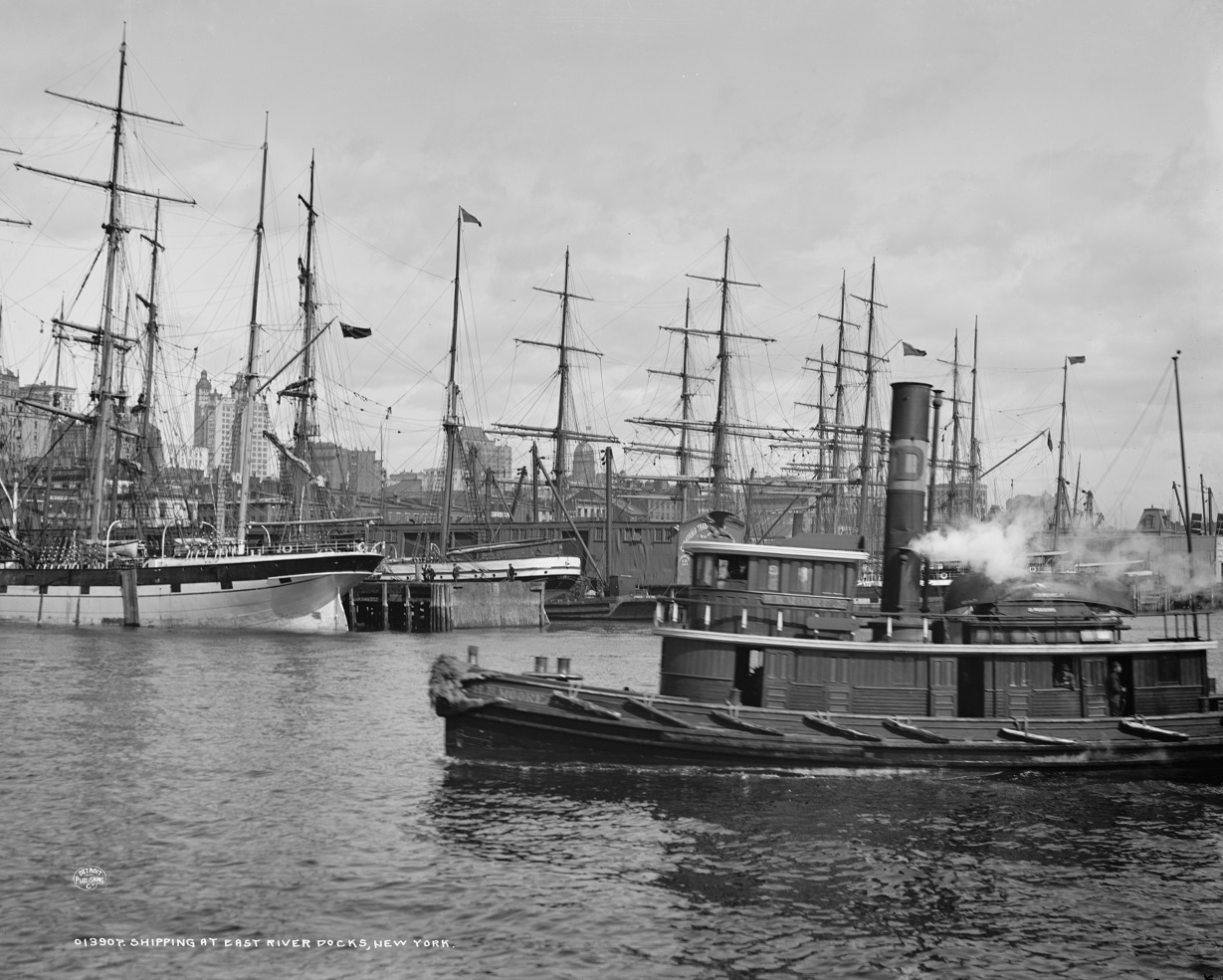
H.B. MOORE JR.
Built in 1896, by A.C. Brown and Son of Tottenville, New York as the H.B. Moore Jr. for Sivert J. Kron of New York, New York.
The tug was later acquired by the Canal-Lakes Towing Company of New York, New York. Where she was renamed as the Calatco No. 4.
In 1947, she was acquired by the McAllister Brothers Towing Company of New York, New York. Where the tug was renamed as the Dorothy McAllister.
In 1958, the tug went out of documentation. Her current and or final disposition is unknown. She was a single screw tug, rated at 210 horsepower.
Vessel Name: H.B. MOORE JR.
USCG Doc. No.: 096345
Vessel Service: TOWING VESSEL
Trade Indicator: Coastwise Unrestricted
Hull Material: WOOD
Ship Builder: A.C. Brown and Son
Year Built: 1896
Length: 60
Hailing Port: NEW YORK, NY.
Hull Depth: 7.5
Hull Breadth: 18.1
Gross Tonnage: 53
Previous Vessel Names:
H.B. Moore Jr., Calatco No. 4, Dorothy McAllister
Previous Vessel Owners:
Sivert J. Kron, Canal-Lakes Towing Co., McAllister Bros. Towing Co.
TUGBOAT POETRY
Along the Riverbank
poetrysoup.com
The luminescence of low hanging mist whirls
Agitated winds shiver the tall cottonwoods
The ever present sound of the old river passing
She stands on the small rustic pier daydreaming
Watching the waters carry an old tugboat south
She waves as the captain sounds his sad horn
A breeze catches the hem of her dress, lifting it upward
Her long slender legs and bare feet exposed to morning rays
A single teardrop falls from her troubled eye
She knows she will soon be leaving this magical place
Traveling far to the western desert, and away from her folks
She turns and leaves, making her way up the wet path
She ponders her anxious future amid the vines of honeysuckle
The smell of bacon soon fills her senses as her home appears
Smoke curling down from the antique stone chimney
Porch steps squeak, the screen door slaps, she has decided
© Copyrights G. Jones 2006
Further notes on tugboats:
Detroit publishing No. 013907
East River Docks NY city
Tugboat H.B. Moore Jr. foreground.
Library of Congress collection
History below from Tugboat information
tugboatinformation.com
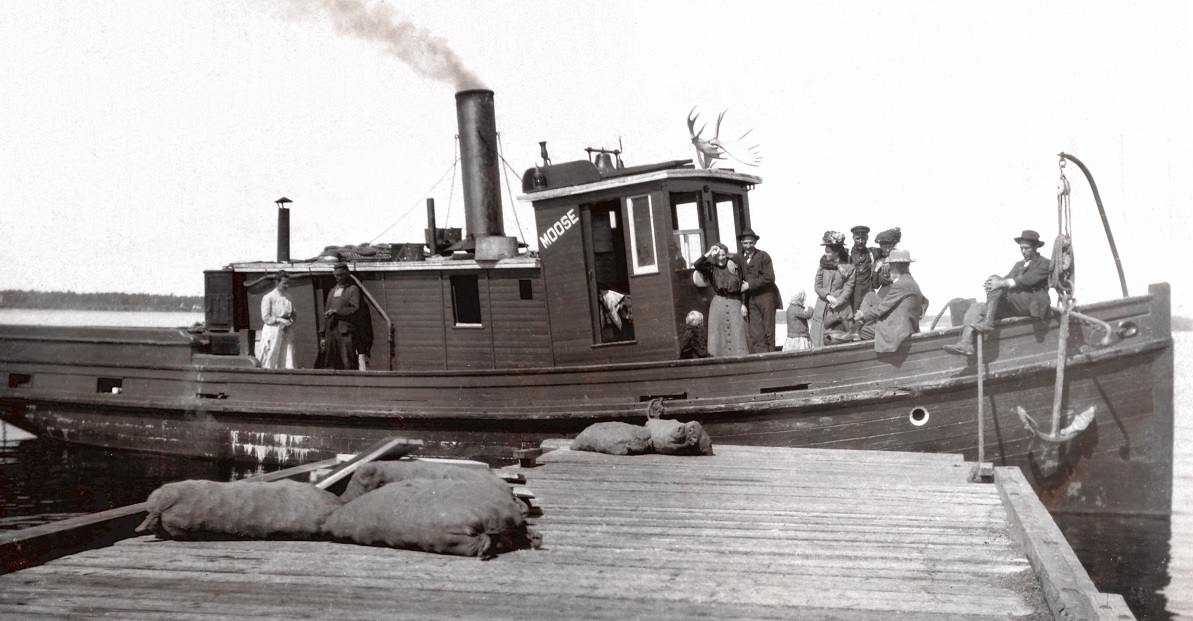
Tugboat MOOSE
Picturesque tugboat MOOSE at a dock at an unknown location, possibly along the East Coast. Gregarious crew members welcomed aboard some happy visitors.
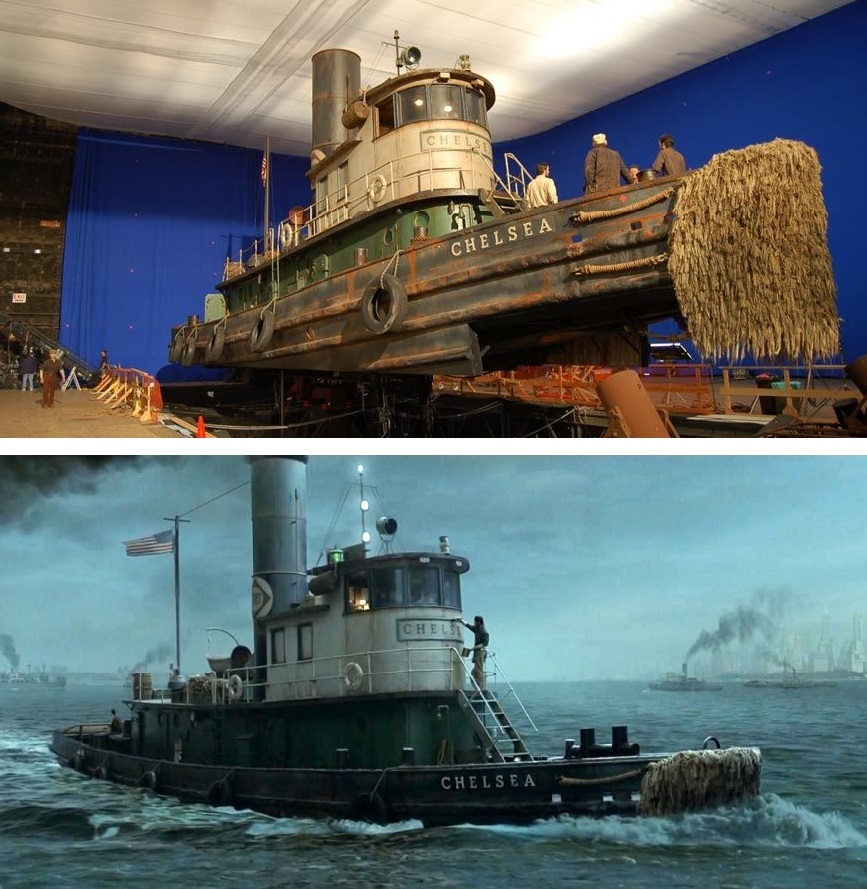
Tugboat CHELSEA in "The Curious Case of Benjamin Button"
Full size mock up of the tugboat CHELSEA on a studio sound stage for "The Curious Case of Benjamin Button" and below that a CGI composite in the film with the CHELSEA at sea. Relevant article below:
Portsmouth tugboats help inspire new Brad Pitt film
By Gina Carbone
January 6, 2009
SEACOASTONLINE.COM
PORTSMOUTH—You could call it "The Curious Case of Tugboat Alley."
Bob and Natalie Hassold and their Bow Street store inspired the tugboat scenes in the new Brad Pitt film, "The Curious Case of Benjamin Button." Of course, they inspired the scenes six years ago and only heard about it last week, but time works differently for Benjamin.
Back in 2002, a man named Eric Roth called Tugboat Alley, saying he was working on a film script based on a short story and wanted information on tugboats. "He said he was the writer of 'Forrest Gump,'" said Natalie at the Portsmouth store on Monday. "I thought 'Mmmhmm. Yeah.'"
The screenwriter had looked up the Tugboat Alley Web site and asked the Hassolds to send him a model of a tugboat. He wanted to put it on his desk for inspiration. He also asked for any background information they had on tugboats.
The Hassolds didn't remember the name of the story if Roth mentioned it, and didn't think much would come of the script. However, they sold him a model of the Eugene F. Moran tugboat, plus chapters from "The Moran Story," an out-of-print book on the Moran family.
And that was it for six years. Last week, on New Year's Eve, Natalie was reading the "Benjamin Button" review in the Portsmouth Herald's Spotlight magazine and noticed the reference to tugboats.
"I said, 'Bob, do you remember that man who called us ...?' "
They bought tickets to the film and the puzzle pieces fell into place. In the script, the backward-aging Benjamin, played by Pitt, lives in New Orleans and works on a tugboat that ends up in a skirmish with a German U-Boat during World War II. At one point, the tugboat's hull smashes the top of a sub's conning tower. That scene was directly inspired by one the chapters in "The Moran Story" where the Edmond J. Moran hit a U-Boat in 1942. The tugboat Benjamin is on in the film is named CHELSEA, and it's yellow instead of red, but they could clearly see the letters MBT and heard a character speak the words "Moran Brothers Towing."
"We were flipping out," Natalie said. "'Oh my God, this is the guy!'"
After seeing the movie, the Hassolds did some detective work through their files to track Roth down. They got his number in Malibu, Calif., and gave him a call.
Turns out Roth was indeed the writer of "Forrest Gump" and he had called back in 2002 regarding his adaptation of F. Scott Fitzgerald's "The Curious Case of Benjamin Button." That short story had no actual mention of tugboats until Roth came along and made Benjamin work on one.
"He said he thought it was an interesting thing for a young man to have done," Natalie said. "He said 99 percent of the script was his imagination." (Forrest Gump also worked on a boat, so it seems to be something of a theme with Roth.)
Both Bob and Natalie said they thought the film was great, even without their own involvement, although it certainly isn't hurting. Roth told them whenever anyone asks about tugboats, he sends them to Tugboat Alley's site. Plus, Bob said, there's talk of Paramount Pictures contacting them for small tugboat models for merchandising purposes.
"The connection is unbelievable," Bob said. "The way it all transpired."
"The Curious Case of Benjamin Button" has been nominated for five Golden Globe awards, including Best Picture-Drama. The awards will be handed out on Sunday. Oscar nominations will be announced Jan. 22 with those awards announced Feb. 22.
So it is possible a Portsmouth business could be involved in an Oscar-winning film.
"Bob asked (Roth) if we had tickets for the Academy Awards," Natalie said with a laugh. "He said those are pretty hard to come by."
Maybe try again in six years.

With the exception of images credited to public institutions,
everything on this page is from a private collection.
Please contact Steamboats.com for permission for commercial use.*
All captions provided by Dave Thomson, Steamboats.com primary contributor and historian.
